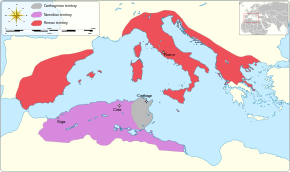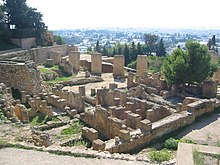Third Punic War
The Roman campaign suffered repeated setbacks through 149 BC, only alleviated by Scipio Aemilianus, a middle-ranking officer, distinguishing himself several times.
At the annual election of Roman magistrates in the spring of 147 BC the public support for Scipio was so great that the usual age restrictions were lifted to allow him to be appointed consul and commander in Africa.
Scipio's term commenced with two Carthaginian successes, but he tightened the siege and started to build a large mole to prevent supplies from getting into Carthage via blockade runners.
[13][14] Other ancient accounts of the Third Punic War or its participants which have also been largely lost include those of Plutarch, Dio Cassius[15] and the Greek Diodorus Siculus.
[21] In the mid-2nd century BC Rome was the dominant power in the Mediterranean region,[22] while Carthage was a large city-state in the north east of what is now Tunisia.
[30] At the end of the war Masinissa, an ally of Rome, emerged as by far the most powerful ruler among the Numidians, the indigenous population which controlled much of what is now Algeria and Tunisia.
In 151 BC Carthage raised a large army commanded by the previously unrecorded[33] general Hasdrubal and, the treaty notwithstanding, counter-attacked the Numidians.
[41][42] The opposing faction included Scipio Nasica, who argued that fear of a strong enemy such as Carthage would keep the common people in check and avoid social division.
[47] These include: a Roman fear of Carthaginian commercial competition;[48][49][50] a desire to forestall a wider war which might have broken out with the death of Masinissa, who was aged 89 at the time;[51] the factional use of Carthage as a political "bogeyman", irrespective of its true power;[52][53] a greed for glory and loot;[48][54] and a desire to quash a political system which Rome considered anathema.
[34][58] The Romans elected two men each year, known as consuls, as senior magistrates, who at time of war would each lead an army; on occasion their term of office was extended.
[63][68] The city had few reliable sources of ground water but possessed a complex system to catch and channel rainwater and many cisterns to store it.
[73] Appian gives the strength of the Roman army which landed in Africa as 84,000 soldiers; modern historians estimate it at 40,000–50,000 men, of whom 4,000 were cavalry.
In often confused fighting Scipio distinguished himself further by his role in thwarting these; the discipline which he imposed on his troops was in contrast with the behaviour of most of the rest of the Roman army.
Scipio led 300 cavalrymen in a series of limited and well-disciplined charges and threats which caused the Carthaginians to pause long enough for most of the infantry to complete their retreat.
[81] Scipio made contact with several of the leaders of Carthage's Numidian cavalry, then joined a second, better-planned expedition led by Manilius against Hasdrubal at Nepheris.
He pulled back the close siege of Carthage to a looser blockade and attempted to mop up the other Carthaginian-supporting cities in the area.
He failed: Neapolis surrendered and was subsequently sacked, but Aspis withstood assaults from both the Roman army and navy, while Hippo was fruitlessly besieged.
Public demand to appoint him as consul and so allow him to take charge of the African war, was so strong that the Senate put aside the age requirements for all posts for the year.
[89][90] The renewed close siege cut off landward entry to the city, but a tight seaward interdiction was all but impossible with the naval technology of the time.
Frustrated at the amount of food being shipped into the city, Scipio built an immense mole to cut off access to the harbour via blockade runners.
In the ensuing Battle of the Port of Carthage the Carthaginians held their own, but when withdrawing at the end of the day many of their ships were trapped against the city's sea wall and sunk or captured.
Here, over several months, they constructed a brick structure as high as the city wall, which enabled up to 4,000 Romans to fire onto the Carthaginian ramparts from short range.
[93] On the last day Scipio agreed to accept prisoners, except for 900 Roman deserters in Carthaginian service, who fought on from the Temple of Eshmoun and burnt it down around themselves when all hope was gone.
Hasdrubal's wife, watching from a rampart, then blessed Scipio, cursed her husband and walked into the temple with her children to burn to death.
[104][105][106] Many of the religious items and cult-statues which Carthage had pillaged from Sicilian cities and temples over the centuries were returned with great ceremony.
[111] The Punic cities which had stood by Carthage to the end were forfeit to Rome as ager publicus, or, as in the case of Bizerte, were destroyed.
[112][113] The Romans did not interfere in the locals' private lives and Punic culture, language and religion survived, and is known to modern scholars as "Neo-Punic civilization".
Conservatives argued against the law and after its passage spread rumours that markers delimitating the new settlement had been dug up by wolves – a very poor omen.
[122][123] Rome still exists as the capital of Italy; the ruins of Carthage lie 16 km (10 mi) east of modern Tunis on the North African coast.
[24] A symbolic peace treaty was signed by Ugo Vetere and Chedli Klibi, the mayors of Rome and modern Carthage, respectively, on 5 February 1985; 2,131 years after the war ended.





